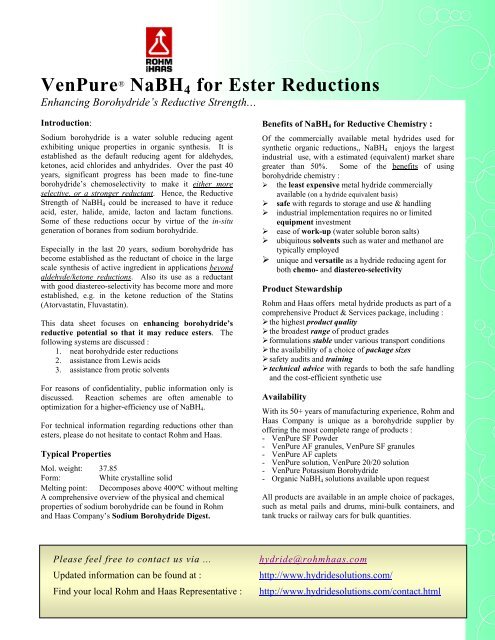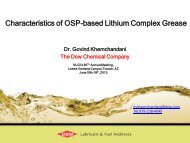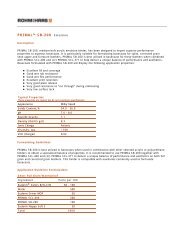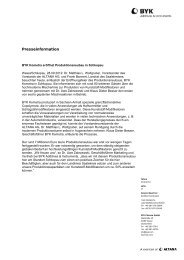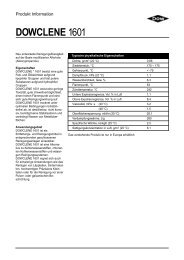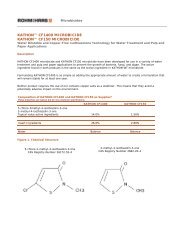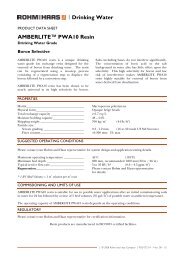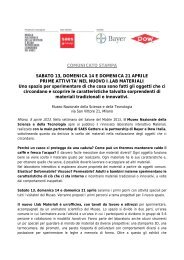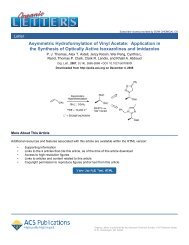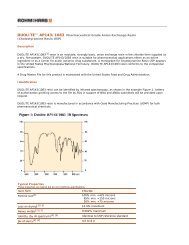VenPure® solution - The Dow Chemical Company
VenPure® solution - The Dow Chemical Company
VenPure® solution - The Dow Chemical Company
You also want an ePaper? Increase the reach of your titles
YUMPU automatically turns print PDFs into web optimized ePapers that Google loves.
VenPure ® NaBH4 for Ester Reductions<br />
Enhancing Borohydride’s Reductive Strength…<br />
Introduction:<br />
Sodium borohydride is a water soluble reducing agent<br />
exhibiting unique properties in organic synthesis. It is<br />
established as the default reducing agent for aldehydes,<br />
ketones, acid chlorides and anhydrides. Over the past 40<br />
years, significant progress has been made to fine-tune<br />
borohydride’s chemoselectivity to make it either more<br />
selective, or a stronger reductant. Hence, the Reductive<br />
Strength of NaBH4 could be increased to have it reduce<br />
acid, ester, halide, amide, lacton and lactam functions.<br />
Some of these reductions occur by virtue of the in-situ<br />
generation of boranes from sodium borohydride.<br />
Especially in the last 20 years, sodium borohydride has<br />
become established as the reductant of choice in the large<br />
scale synthesis of active ingredient in applications beyond<br />
aldehyde/ketone reductions. Also its use as a reductant<br />
with good diastereo-selectivity has become more and more<br />
established, e.g. in the ketone reduction of the Statins<br />
(Atorvastatin, Fluvastatin).<br />
This data sheet focuses on enhancing borohydride’s<br />
reductive potential so that it may reduce esters. <strong>The</strong><br />
following systems are discussed :<br />
1. neat borohydride ester reductions<br />
2. assistance from Lewis acids<br />
3. assistance from protic solvents<br />
For reasons of confidentiality, public information only is<br />
discussed. Reaction schemes are often amenable to<br />
optimization for a higher-efficiency use of NaBH4.<br />
For technical information regarding reductions other than<br />
esters, please do not hesitate to contact Rohm and Haas.<br />
Typical Properties<br />
Mol. weight: 37.85<br />
Form: White crystalline solid<br />
Melting point: Decomposes above 400 o C without melting<br />
A comprehensive overview of the physical and chemical<br />
properties of sodium borohydride can be found in Rohm<br />
and Haas <strong>Company</strong>’s Sodium Borohydride Digest.<br />
Benefits of NaBH4 for Reductive Chemistry :<br />
Of the commercially available metal hydrides used for<br />
synthetic organic reductions,, NaBH4 enjoys the largest<br />
industrial use, with a estimated (equivalent) market share<br />
greater than 50%. Some of the benefits of using<br />
borohydride chemistry :<br />
� the least expensive metal hydride commercially<br />
available (on a hydride equivalent basis)<br />
� safe with regards to storage and use & handling<br />
� industrial implementation requires no or limited<br />
equipment investment<br />
� ease of work-up (water soluble boron salts)<br />
� ubiquitous solvents such as water and methanol are<br />
typically employed<br />
� unique and versatile as a hydride reducing agent for<br />
both chemo- and diastereo-selectivity<br />
Product Stewardship<br />
Rohm and Haas offers metal hydride products as part of a<br />
comprehensive Product & Services package, including :<br />
� the highest product quality<br />
� the broadest range of product grades<br />
� formulations stable under various transport conditions<br />
� the availability of a choice of package sizes<br />
� safety audits and training<br />
� technical advice with regards to both the safe handling<br />
and the cost-efficient synthetic use<br />
Availability<br />
With its 50+ years of manufacturing experience, Rohm and<br />
Haas <strong>Company</strong> is unique as a borohydride supplier by<br />
offering the most complete range of products :<br />
- VenPure SF Powder<br />
- VenPure AF granules, VenPure SF granules<br />
- VenPure AF caplets<br />
- VenPure <strong>solution</strong>, VenPure 20/20 <strong>solution</strong><br />
- VenPure Potassium Borohydride<br />
- Organic NaBH4 <strong>solution</strong>s available upon request<br />
All products are available in an ample choice of packages,<br />
such as metal pails and drums, mini-bulk containers, and<br />
tank trucks or railway cars for bulk quantities.<br />
Please feel free to contact us via … hydride@rohmhaas.com<br />
Updated information can be found at : http://www.hydride<strong>solution</strong>s.com/<br />
Find your local Rohm and Haas Representative : http://www.hydride<strong>solution</strong>s.com/contact.html
1. Ester Reductions with Neat NaBH4<br />
A. High Temperature NaBH4 Reductions 1<br />
At room temperature, NaBH4 without solvent or cationic<br />
assistance is not capable of reducing esters. However, at<br />
elevated temperatures, it can reduce ester groups in high<br />
yields. At those temperatures, protic solvents cannot be<br />
used, because the NaBH4 decomposition would be swift.<br />
Solvents like glymes are a valuable alternative.<br />
X<br />
O<br />
OR<br />
NaBH 4<br />
Diglyme<br />
162 o C<br />
X<br />
OH<br />
Whereas academic research typically uses mono- or diglyme<br />
solvents, we recommend to use tri- or tetra-glyme<br />
for large-scale applications, because of their better<br />
toxicological and solubility profile.<br />
Please contact Rohm and Haas if you are interested in<br />
purchasing NaBH4 glyme <strong>solution</strong> (8% in Triglyme)<br />
B. Neighboring Group Participation 2<br />
Sodium borohydride can reduce hydroxy-esters in nonpolar<br />
solvents such as toluene in high yields. It is believed<br />
that the hydroxy-function enhances borohydride’s<br />
reductive strength in much the same way as water or<br />
methanol do as a solvent (see hereunder)<br />
EtO<br />
O<br />
HO<br />
Cl<br />
1) 1NaBH 4 , Toluene, 55 o C 3 h<br />
2) 10 o C, 1 mole Con HCl/water<br />
Yield 92 %<br />
This methodology has proven to be economically viable in<br />
the synthesis of intermediates for both Pharmaceutical and<br />
Agrochemical Active Ingredients.<br />
E.g. in the synthesis of Lipoic acid, a vic-diol has to be<br />
obtained in the presence of an ester function. This can be<br />
achieved by the selective reduction of an hydroxy-ester to<br />
the corresponding diol. <strong>The</strong> reaction proceeds by using 1<br />
equivalent of NaBH4 in THF, and results in less than 10%<br />
of the over-reduction 3 . It should be noted that in<br />
experiments where the hydroxy group was protected, no<br />
ester reduction was observed.<br />
MeO<br />
O OH<br />
O<br />
OMe<br />
NaBH 4, THF<br />
Reflux, 6h<br />
H<br />
H<br />
OH OH<br />
HO<br />
HO<br />
O<br />
Cl<br />
OMe<br />
Factors affecting the yields and reaction products include<br />
solvent used, excess of sodium borohydride Used and<br />
length of chain 4 . I n a recent patent it was described that the<br />
solvent-free route affords yields up to 90 % 5 .<br />
C. Esters to 2° Alcohols 6<br />
An ester is the retro-synthetical synthon of the<br />
corresponding primary alcohol. Recently it has been<br />
demonstrated that esters can be converted into secondary<br />
alcohols in a one-pot two-step synthesis. Following a<br />
Grignard addition to an ester, the intermediate is<br />
subsequently reduced by zinc borohydride<br />
0.25 Zn(BH 4) 2 + 4 R"MgBr<br />
R"= Alkyl, Cyclic, Aryl, Allylic<br />
R'= Me, Et<br />
O<br />
R O R'<br />
THF, RT<br />
OH<br />
R R"<br />
60-82 % yield<br />
X R ratio time yield<br />
Zn(BH 4)2/ Substrate<br />
H H 0.6 1h 82<br />
Cl H 1 2h 87<br />
Cl Me 0.6 1h 86<br />
Cl i-Pr 0.6 2h 92<br />
Cl t-Amyl 0.6 5h 95<br />
Hallouis, S.; Saluzzo, C.; Amouroux, R. Synth. Commun. 2000, 30, 313<br />
Zinc borohydride is often used in academic research for<br />
chemo-selective reductions, such as the reduction of an<br />
aldehyde in the presence of a ketone. Unfortunately,<br />
Zn(BH4)2 is not sufficiently stable to be commercialized<br />
for large-scale usage. <strong>The</strong>refore, it is recommended that it<br />
be generated it in-house, from NaBH4 and ZnCl2.<br />
Feel free to contact Rohm and Haas’ Technical Support<br />
Team for further details on in-situ generation of zinc<br />
borohydride.
Cl<br />
2. Assistance from Lewis Acids<br />
<strong>The</strong> use of metal cations additives such as LiCl 7 , AlCl3 8 ,<br />
ZnCl2 9 and CaCl2 10 to modify the reactivity of sodium<br />
borohydride is well known. Examples of these systems are<br />
shown below.<br />
A. Sodium Borohydride and AlCl3 8<br />
H.C Brown and co-workers have demonstrated in the<br />
1950s that the combination of aluminum trichloride with<br />
sodium borohydride in tetrahydrofuran results in a<br />
significant increase in Borohydride’s Reductive Strength.<br />
<strong>The</strong> combination NaBH4 / AlCl3 is a cost-effective system<br />
for the reduction of a myriad of functional groups. Esters<br />
are reduced to alcohols in high yields under mild reaction<br />
conditions.<br />
B. Sodium Borohydride and ZrCl4 11<br />
More recently, zirconium borohydride has been recognized<br />
as an economical reducing system for esters, even when<br />
the Zr-salt cannot be recycled for re-use. Also Zrborohydride<br />
is a rather non-selective reducing system, that<br />
will reduce a variety of functional groups.<br />
O<br />
R OR'<br />
0.125 [ZrCl 4/ 4 NaBH 4]<br />
THF, 0-RT<br />
2h<br />
H H<br />
R OH<br />
Yield (%)<br />
Methyl 10-undeceneoate 93<br />
Methyl Myristate 95<br />
Methyl Laurate 90<br />
Ethyl Benzoate 91<br />
Dimethyl Brassylate 93<br />
Dimethyl Terephthalate 92<br />
Ethyl 2- Chlorobenozate 95<br />
Methyl 4-Nitrobenzoate 95<br />
Methyl 4-Hydroxybenzoate 96<br />
Narasimhan, S.; Balakumar, R. Synth. Commun. 2000, 20, 4387<br />
C. Ca(BH4)2: in-situ generation from NaBH4 12<br />
Calcium borohydride is a very cost-effective ester reducing<br />
system, especially when methanol is the desired reaction<br />
solvent. An example of this is the synthesis of a<br />
intermediate for a anti-psychotic drug shown below. 13<br />
N<br />
O<br />
O<br />
O<br />
0.93 NaBH 4, 1.23 CaCl 2<br />
MeOH, Yield 92 %<br />
Unfortunately, Ca-borohydride is not sufficiently stable to<br />
be commercialized for large-scale usage. <strong>The</strong>refore, we<br />
recommend that it is generated in-house, from NaBH4 and<br />
Cl<br />
N<br />
O<br />
OH<br />
CaCl2. Feel free to contact Rohm and Haas’ Technical<br />
Support Team for further details.<br />
D. LiBH4 in THF : in-situ from NaBH4<br />
Lithium borohydride has two advantages over neat NaBH4:<br />
1. it is soluble in THF (and glymes)<br />
2. it reduces esters without any assistance<br />
Lithium borohydride can be generated in-situ from sodium<br />
borohydride and lithium chloride or bromide. 7 It is<br />
typically used under reflux for the reduction of methyl<br />
esters, however, for the more sterically hindered ethyl<br />
ester, reduction can also proceed in acceptable yields<br />
O<br />
R O R'<br />
LiBH 4<br />
Et 2O/toluene, reflux<br />
R O H<br />
Time(h) Yield<br />
Ethyl caproate 0.25 86<br />
Ethyl benzoate 1.0 90<br />
Ethyl-p-chlorobenzoate 0.5 90<br />
Ethyl-m-bromobenzoate 0.5 94<br />
Ethyl-p-nitrobenzoate 0.25 70<br />
Ethyl-p-methoxybenzoate 2.0 96<br />
Diethyldimethylmalonate 0.25 83<br />
Brown, H.C.; Narasimhan, S.; Choi, Y.M. J. Org. Chem. 1982, 47,<br />
4702<br />
Please contact Rohm and Haas’ Technical Support team<br />
for recommendations on the in situ generation of LiBH4.<br />
E. NaBH4 with Li-salt Added as a Lewis Acid<br />
<strong>The</strong> one pot reduction of ester groups using sodium<br />
borohydride and lithium chloride in a polar aprotic<br />
solvents is a popular methodology 14 ..<br />
However, it is worth noting that the one-pot chemistry<br />
seems less kinetic than when LiBH4 is generated in a<br />
separate step, with subsequent removal of NaCl.<br />
N<br />
N<br />
N<br />
O<br />
F<br />
O<br />
F<br />
O<br />
O<br />
2.1 NaBH 4, 2.1 LiCl<br />
EtOH, , 0 oC, 4h Yield 54 %<br />
N<br />
N<br />
This hurdle may be overcome by using higher reaction<br />
temperatures.<br />
N<br />
OH<br />
F<br />
F<br />
OH<br />
OH
O<br />
1 NaBH4, 1 LiCl<br />
R<br />
diglyme, 162 o C<br />
OH<br />
H<br />
R Time Yield<br />
Me 5 85<br />
i Pr 5 83<br />
t-Amyl 5 0<br />
Mita, N.; Nagase, H.; Iizuka, H.; Oguchi, T.; Sakai, K.;<br />
Horikomi, K.; Miwa, T.; Takahashi, S. EP 0839805; 1998<br />
3. Assistance from Protic Solvents.<br />
When sodium borohydride is dissolved in a protic solvent,<br />
it will react with the solvent according to the equation<br />
NaBH4 + x HOR � NaBHx(OR)4-x + x H2<br />
<strong>The</strong> resulting borohydride derivative, NaBHx(OR)4-x, is a<br />
stronger reductant than neat NaBH4 (this is due to<br />
electron-donation from the oxygen ligands).<br />
<strong>The</strong> art of using this technology resides in finding the<br />
optimum reaction conditions that allow for the formation<br />
of the strongly reducing borohydride derivative, without<br />
loosing all of the hydrides to solvolysis. Indeed, if all 4<br />
hydrides react with the protic solvent, then NaB(OR)4 is<br />
formed, which has ZERO reducing strength :<br />
NaBH4 + 4 HOR � NaB(OR)4 + 4 H2<br />
Methanol is by far the most efficient solvent in enhancing<br />
borohydride’s reductive strength. Water and ethanol are<br />
second best, however, water is typically not a good solvent<br />
for (longer chain) esters.<br />
Ethanol would be a good solvent, however NaBH4 only<br />
dissolves up to 4% in it. If one wants to use e.g. a 10%<br />
NaBH4 dispersion in ethanol, then we recommend the use<br />
of Rohm and Haas’ VenPure SF powder, which has a<br />
small particle size (increased active surface).<br />
<strong>The</strong> solubility of NaBH4 in water and methanol is higher<br />
than 15%. Hence, for making large quantities of a NaBH4<br />
<strong>solution</strong> in these 2 solvents, we recommend to use an<br />
easier-to-handle, larger particle size, such as provided by<br />
VenPure SF granules or VenPure AF caplets.<br />
VenPure SF powder VenPure SF granules Venpure AF caplets<br />
H<br />
Hereunder are some examples of the use of protic solvents<br />
for enhancing Borohydride’s Reducing Strength.<br />
A. Mixture : Water / Dioxane 15<br />
O<br />
Me<br />
R O<br />
7-10 hydride eq NaBH 4<br />
Water or Water/Dioxane,<br />
RT, 2-24 h<br />
R O H<br />
Substrate Time(h) Yield<br />
PhCO2Me 12 80<br />
2-ClPhCO2Me 6 100<br />
2-NO2PhCO2Me 2 100<br />
2-MePhCO2Me 12 80<br />
2-MeOPhCO2Me 24 60<br />
Bianco, A.; Passacantilli, P.; Righi, G. Synth. Commun. 1988, 18, 1765<br />
B. Mixture : an organic solvent / methanol 16<br />
MeO<br />
O<br />
OH OH<br />
NaBH4 OMe<br />
O<br />
US 6,479,714 B1, Nov 12, 2002<br />
Solvent, MeOH<br />
RT<br />
OH<br />
Solvent Temp Time Ratio Yield<br />
(°C) Sub /NaBH4 %<br />
THF/MeOH 65 1h 1 / 3.5 99<br />
THF/MeOH 68 2.5 1 / 1.8 95<br />
Spirits/MeOH 0 22h 1 / 1.79 100<br />
THF/ i PrOH 50 6h 1 / 1.8 85<br />
iPrOH 50 7h 1 / 1.80 85<br />
THF 25 17h 1 / 1.80 90<br />
This technique is often used on larger-scale, as it is a<br />
compromise between using the solubility characteristics of<br />
THF, and the Reductive Strength Enhancing capability of<br />
methanol.<br />
C. Ethanol<br />
In the above two examples the reactive protic solvent,<br />
methanol or water, is diluted with a non-reactive solvent<br />
This is done in order to minimize the amount of sodium<br />
borohydride that is lost due to solvolysis decomposition. In<br />
some instances, a 2-solvent system may not be optimal. It<br />
is then possible to replace it by one protic solvent that<br />
decomposes NaBH4 less rapidly. Ethanol 17 and<br />
polyethylene glycol 18 are such solvents. <strong>The</strong>y have the<br />
advantage that borohydride’s solvolysis rate is<br />
substantially slower then in methanol. On the other hand,<br />
their enhancing effect will be less pronounced.<br />
.<br />
OH
D. Methanol<br />
Another way to minimize the rate of solvolysis of NaBH4<br />
in protic solvent is to increase the solvent’s alkalinity. An<br />
example of this is to add sodium methoxide to a sodium<br />
borohydride <strong>solution</strong> in methanol. <strong>The</strong> rate of solvolysis is<br />
then reduced by more then 90 %.<br />
% NaBH4 consumed<br />
100<br />
80<br />
60<br />
40<br />
20<br />
5. Overview<br />
0<br />
0 10 20 30 40<br />
Time (minutes)<br />
No NaOMe<br />
added<br />
0.010 N<br />
NaOMe<br />
As a summary, please find hereunder a table with proven<br />
Reductive Technologies for reduction of Ethyl Benzoate.<br />
Metal moles Time Temp Additive Solvent Yield<br />
Hydride h<br />
o<br />
C<br />
(
6. References<br />
1) Zhu, H.J., Piittman, C.U. Synthetic<br />
Commun. 2003, 33, 1733<br />
2) US 6,359,155 B1 Mar 19, 2002<br />
3) US 5,530,143 B2 June 25,1996<br />
4) Private communications with Dr. Martin<br />
J. Klatt of the BASF Corporation<br />
5) US 6,620,964 B2 Sep 16, 2003<br />
6) Hallouis, S., Saluzzo, C., Amouroux, R.<br />
Synth. Commun. 2000, 30, 313<br />
7) Brown, H.C.; Narasimhan, S.; Choi,<br />
Y.M. J. Org. Chem. 1982, 47, 4702<br />
8) Brown, H.C.; Subba Rao, B.C. J. Am.<br />
Chem. Soc. 1956, 78, 2582<br />
9) Yamakawa, T.; Masaki, M.; Nohira, H.<br />
Bull. Chem. Soc. Japan 1991, 64, 2730<br />
10) Narasimhan , S.; Ganeshwar Prasad, K.;<br />
Madhaven, S. Synth. Commun. 1995, 25,<br />
1689<br />
11) Narasimhan, S.; Balakumar, R. Synth.<br />
Commun. 2000, 20, 4387<br />
12) Ikunaka, M.; I.; Matsumoto, J.; Fujima,<br />
Y.; Hirayama, Y. Org. Proc. Res. Dev.<br />
2002 6, 49<br />
13) Saksena, A.K.; Girijavallabhan, V.M.;<br />
Lovey, R.G.; Pike, R.E.; Wang, H.; Liu,<br />
Y.-T.; Ganguly, A.K.; Bennett, F. EP<br />
0773941 B1 2003<br />
14) Mita, N.; Nagase, H.; Iizuka, H.; Oguchi,<br />
T.; Sakai, K.; Horikomi, K.; Miwa, T.;<br />
Takahashi, S. EP 0839805; 1998<br />
15) Bianco, A.; Passacantilli, P.; Righi, G.<br />
Synth. Commun. 1988, 18, 1765<br />
16) Soai, K.; Oyamada, H.; Takase, M.;<br />
Ookawa, A. Bull. Chem. Soc. Jpn. 1984,<br />
57, 1948<br />
17) US 2003/0045759 Mar 6, 2003<br />
18) Itsuno, S.; Sukurai, Y.; Ito, K. Synthesis<br />
1988, 995<br />
19) Brown, H.C.; Narasimhan, S. J. Org.<br />
Chem. 1982, 47, 1606<br />
20). Gurjar, M.K., Murugaiah, A. M. S.,<br />
Reddy, D.S.; Chorghade M.S. Org.<br />
Proc. Res. Dev. 2003, 7, 309<br />
® trademark of Rohm and Haas <strong>Company</strong> or its subsidiaries or affiliates 09/03<br />
To the best of our knowledge the information contained herein is correct. All products may present unknown health hazards and should be<br />
used with caution. Although certain hazards are described herein, we cannot guarantee that these are the only hazards which exist. Final<br />
determination of suitability of the product is the sole responsibility of the user. Users of the product should satisfy themselves that the<br />
conditions and methods of use assure that the product is used safely. NO REPRESENTATIONS OR WARRANTIES, EITHER EXPRESS OR<br />
IMPLIED, OF MERCHANTABILITY, FITNESS FOR A PARTICULAR PURPOSE OR ANY OTHER NATURE ARE MADE HEREUNDER WITH<br />
RESPECT TO THE INFORMATION CONTAINED HEREIN OR THE PRODUCT TO WHICH THE INFORMATION REFERS. Nothing herein is<br />
intended as a recommendation to use our products so as to infringe any patent. We assume no liability for customer’s violation of patent or<br />
other rights. <strong>The</strong> customer should make his own patent investigation relative to his proposed use.


